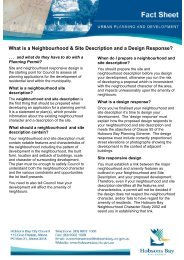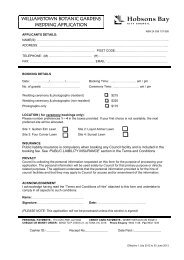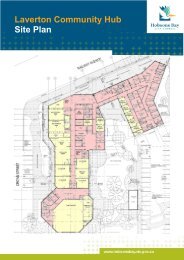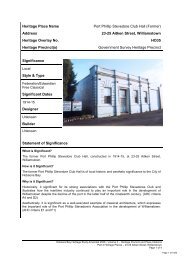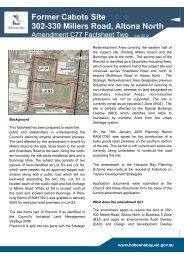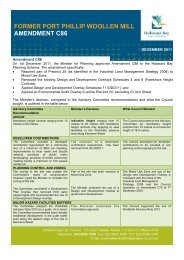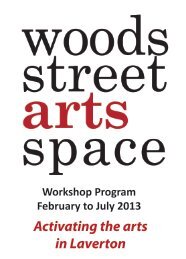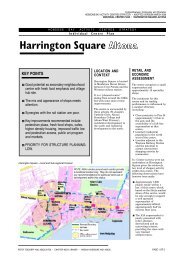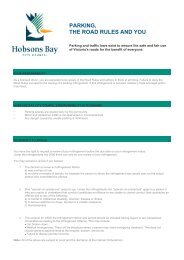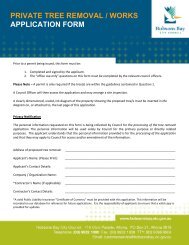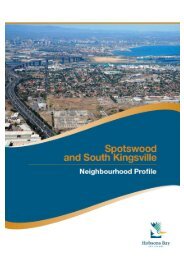Sustainable - Hobsons Bay
Sustainable - Hobsons Bay
Sustainable - Hobsons Bay
Create successful ePaper yourself
Turn your PDF publications into a flip-book with our unique Google optimized e-Paper software.
5.1.6 Summary visitor analysis<br />
The above data highlights the dominance of lower<br />
yielding short stay day trippers to <strong>Hobsons</strong> <strong>Bay</strong><br />
combined with very strong weekend seasonality –<br />
further accentuated by a strong summer bias. The data<br />
indicates the need to smooth seasonality and increase<br />
visitor yield. This would provide a stronger economic<br />
base for the tourism businesses without reducing the<br />
local amenity of the area.<br />
5.2 Economic & employment<br />
impact of tourism<br />
According to the Tourism & Transport Forum 17 ,<br />
there were 3,211 people employed in tourism in the<br />
federal electorate of Gellibrand 18 in 2002/03. This was<br />
5.7% of the electorate’s total employment of 55,872 at<br />
the time.<br />
The strongest sector<br />
for tourism related<br />
employment in Victoria is the<br />
accommodation, cafes and<br />
restaurants sector (a 36% reliance<br />
on tourism demand) followed by the transport and<br />
storage sector (a 15.7% reliance). 19<br />
Matching this employment data to Australian<br />
Bureau of Statistics research, 20 it is estimated that<br />
annual tourism related expenditure in Gellibrand is<br />
approximately $365 million.<br />
The cultural tourism survey of 1996 21 asked visitors<br />
what they spent on the following items – the average<br />
expenditure is indicated at the top of the following<br />
page:<br />
• Food and drink $18.33<br />
• Shopping $9.03<br />
• Transport $1.95<br />
• Souvenirs $0.20<br />
• Entrance fees $1.14<br />
• Day tours $0.39<br />
• Gambling $0.40<br />
This data indicates visitors spend more on ‘food and<br />
drink’ than anything else. Most visitors (61%) spend<br />
between $6–$20 (1996 prices) with average spending<br />
of $18.33. Shopping was next, however most visitors<br />
(69%) only spend $0–$5 with an average spending<br />
of $9.<br />
Adjusted to current dollar values the data suggests that<br />
the average visitor may spend $15–$27 for food or<br />
entertainment and $8–$15 for shopping items such as<br />
souvenirs and art/craft.<br />
Wider industry forecasts for tourism in Australia are<br />
for 1% annual growth in domestic tourism and 4 – 6%<br />
annual growth in inbound or international tourism. 22<br />
5.2.1 Summary economic and<br />
employment analysis<br />
The economic and employment impact of tourism in<br />
<strong>Hobsons</strong> <strong>Bay</strong> is clearly significant, accounting for an<br />
estimated 5–6% of employment. Given the dominance<br />
of the Melbourne and domestic markets to <strong>Hobsons</strong><br />
<strong>Bay</strong> the forecast flat domestic market growth suggests<br />
the importance of improved tourism marketing and<br />
development efficiencies are going to be required just<br />
to maintain the economic and employment value of<br />
tourism to <strong>Hobsons</strong> <strong>Bay</strong> over the period of this Plan.<br />
18<br />
Gellibrand takes in <strong>Hobsons</strong> <strong>Bay</strong> as well as Tottenham, Yarraville, Footscray, Maidstone and Braybrook.<br />
19<br />
Tourism Victoria Fact Sheet entitled Economic Contribution of Tourism to Victoria 2003–2004 updated October 2005.<br />
20<br />
ABS Cat No. 5249.0. This indicates that there are approximately 8.8 jobs for every $1m spent.<br />
21<br />
This 1996 data is the only information available; it is believed to still reliably reflect current breakdown of spending.<br />
22<br />
Tourism Forecasting Council data 2005.<br />
16 17



